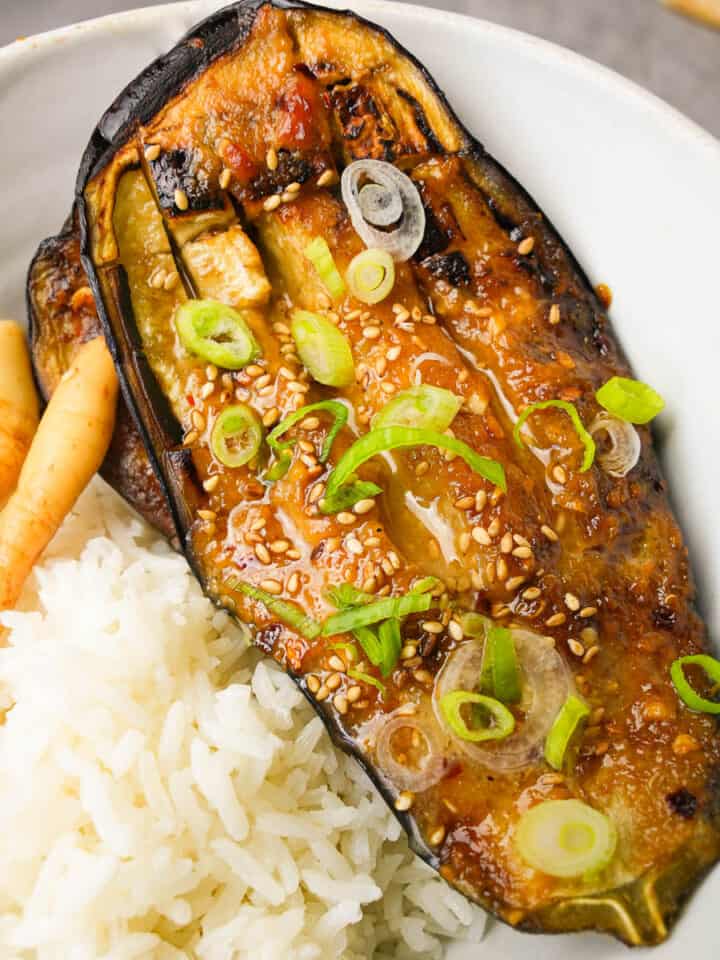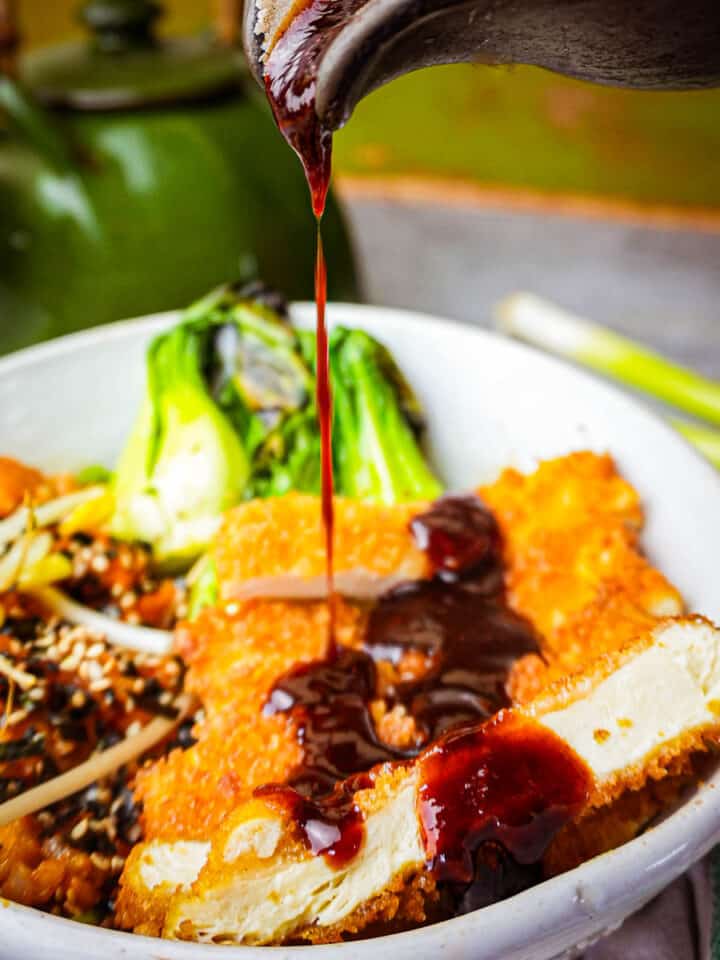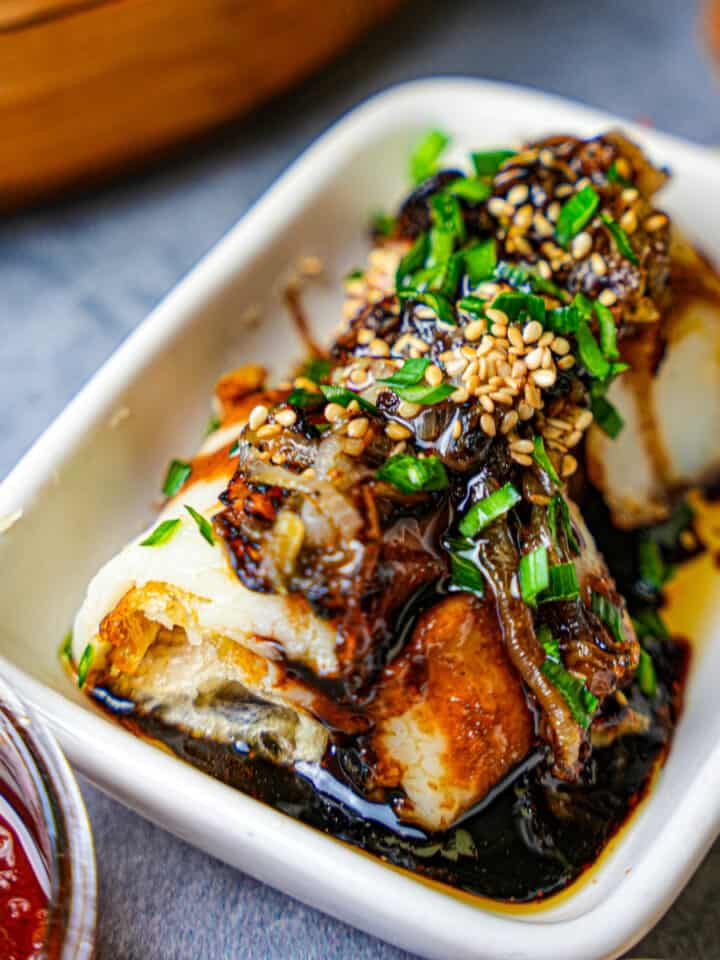*This post may contain affiliate links. Read more »
In Japan, this flavor bomb topping is just about as common to see on tables as salt, pepper, and soy sauce. This shichimi togarashi recipe rivals the best you can find in stores, takes hardly any time to make, and is SUCH an upgrade for your noodles, rice dishes, and grilled foods.


Enter your email & I'll send it to your inbox. Plus, get great new recipes from me every week!
By submitting this form, you consent to receive emails from Cinnamon Snail.
Whether you are looking to swirl some into vegan kewpie mayo to dip vegan fried chicken into or just sprinkling some to finish your vegan sushi bake with pickled yamagobo, you are in for a massive treat.
If your flavor arsenal has been missing this Japanese seven-spice blend, you are about to get the upgrade of the century. Let’s mix up some of your fave new culinary secret weapon!
Jump to:
- 🥰 Why You’ll Love This Shichimi Togarashi Recipe
- 🌶️ Ingredients in Shichimi Togarash
- 🤯Variations
- 📖 How to Make This Shichimi Togarashi Recipe
- 💡What to use this on:
- 👉 Top Tips for Perfect Japanese Seven Spice
- 🤷♀️ Recipe FAQs
- ✌️Use shichimi togarashi on these
- Shichimi Togarashi Recipe (Japanese Seven Spice)
🥰 Why You’ll Love This Shichimi Togarashi Recipe
✊ Vegan AF & GF: Like all of my vegan Japanese recipes, this one is completely free from animal products (and cholesterol!). It’s one of the gluten-free vegan recipes no one will even notice doesn’t have dried fish flakes.
🍊 Citrus: The oils in the dried orange peel (which you can make at home from fresh oranges if you want) bring a vibrant contrast to the umami and spice in the recipe.
🕒 Quick and Easy to Make: This recipe comes together in under 10 minutes with minimal equipment.
✅ Tested and Approved Worldwide: Like all of the vegan recipes I publish, after refining this recipe, I shared it with a massive team of hundreds of testers who prepared it in their own kitchens all around the world.


👩🍳 Learn to make the BEST vegan Japanese food
This 5-day guide to my most popular Japanese recipes is 100% FREE, & you'll love the actual heck out of it 🥰
🌶️ Ingredients in Shichimi Togarash

Sansho Peppercorns
I remember the first time I grew and tasted the medicinal herb spilanthes. It has a weird effect, kinda like you put a battery in your mouth. Anyway, these peppercorns, often referred to as "numbing pepper," have a sorta similar effect due to the presence of hydroxy-alpha-sanshool.
Szechuan peppercorns (aka Sichuan peppercorns) can be used too. If you have some leftover after making this, you should whip up a batch of my chili garlic sauce, another spicy Asian condiment that I think you will love the heck out of.
Dried Orange Peel
Commonly, dried yuzu peel is used in shichimi togarashi. But since fresh and dried yuzu aren’t that common in the US, I wrote this recipe to be made with dried orange peel.
If you have fresh oranges, you can make your own dried orange peel by peeling the most external layer of the orange with a vegetable peeler and either just letting the peels air dry for a few days in a warm, dry location, or by using a food dehydrator. Using an oven to dry the orange peels will turn the peels dark and bitter unless you do it at the lowest possible temperature.
White and Black Sesame Seeds
One name for this condiment is nana-iro tōgarashi, which is sometimes translated as seven color spice. This is one of the reasons the spice blend traditionally uses mixed sesame seeds rather than just one color. In place of black sesame seeds, some shichimi togarashi recipes call for poppy seeds or hemp seeds, but I like it better this way.
Goma means sesame, which explains the name of Japan’s popular goma dressing! Toasting your own unroasted seeds makes the flavor fresher, though pre-toasted seeds will work as long as you toast them more briefly.
Ichimi Togarashi
This recipe is really the best made with ichimi togarashi, Japanese ground red chili flakes.
If you can’t get any, my top two substitution recommendations are gochugaru and Aleppo red pepper flakes. If you have either of those leftover after making this, gochugaru can be used to make vegan kimchi and Korean tofu soup, while Aleppo pepper flakes can be used in vegan Turkish recipes like cranberry ezme and kısır.
Ground Ginger
Dried ginger powder is often a little weak tasting. It wasn’t until I tried the buffalo ginger from Burlap and Barrel that I felt like I finally had tasted dried ginger that had the spicy bite of the fresh stuff!
I love their spices so much that I worked out a special deal with the company for ya. If you order the ginger for this recipe through my link, they will throw you a bottle of their wild mountain cumin seeds (which are insanely good) for free!

Get my fave cumin seeds for free!
Using this link, add the wild mountain cumin to your cart, spend at least $15 on some of the other absurdly good spices from Burlap & Barrel (they all seriously slap) and the bottle of this bangin' wild mountain cumin becomes FREE, and you will love it so much.

Aonori (or Crushed Nori)
Aonori, dried nori seaweed flakes, provide a complex umami flavor and a hint of oceanic saltiness. It’s also super good for you!
Crushed nori (the type used in sushi) can be used in place of aonori, which is often harder to find.
*See the recipe card at the bottom of the page for exact quantities, nutritional info, and detailed cooking directions.
🤯Variations
Citrusy & Smoky Shichimi Togarashi
Make your togarashi smoky with the addition of chipotle powder. Just use it in place of the ichimi togarashi in the recipe, and add a little extra dried orange peel to balance the added heat. This is a full-power lovely zing to adorn soba noodles, grilled proteins, or Japanese miso glazed eggplant with.
Shiso Shichimi Togarashi
Add a small spoonful of kombu powder as an alternative to bonito flakes, and add 2 tablespoons of crushed dried shiso leaves to the mix. This slightly more herbal-tasting togarashi is lovely on tofu, rice bowls, or even sprinkled onto popcorn, or even french fries.
📖 How to Make This Shichimi Togarashi Recipe
Nail this classic Japanese spice blend on your first shot by following these step-by-step photos with helpful tips. Or scroll down to the bottom of this page for the easy-to-print recipe card.

Step One
Toast of the Town:
Heat up a large skillet over medium heat and toss in the Szechuan peppercorns (or sansho peppercorns). Stir them around for 60-90 seconds, keeping an eye out for that heavenly fragrance to kick in.
✅ This sorta wakes up the flavors, releasing all the oils that really enliven the final condiment.

Step Two
Orange You Glad I Didn't Say Banana?
Once the peppercorns are aromatic, add in the dried orange peel and both sesame seeds. Keep stirring for 2-3 minutes until the white sesame seeds start to toast lightly.
✅ Be careful here. You don’t want to burn the seeds or make any of this stuff taste bitter. Use a thick skillet, and keep the contents of the pan moving to just get even light toasting.

Step Three
Grindcore:
Transfer the toasted sesame seeds, sansho pepper, and citrus peel from the pan into a spice grinder, coffee grinder, mortar and pestle, or high-speed blender.
Toss in the ground red chili pepper, aonori (or crushed nori), and ginger, then grind until you have a mostly fine powder, with some little sesame seed bits and orange rind still visible.

Step Four
Pack It Up, Pack It In. Let Me Begin:
If you aren’t going to garnish some vegan tofu katsu with it right this very instant, you are gonna need to pack this up for later.
Carefully transfer your new seasoning blend into an airtight container. Store it in a cool, dry place until you're ready to sprinkle that magic on whatever you're cooking. This spice mix will keep for months if stored properly.
💡What to use this on:
Togarashi is a fantastic way to add some heat to onigiri, or tamari-grilled yaki onigiri. I love this stuff for adding some spicy vibes to wakame salad, somen noodles, and sunomono!
I use a little bit in the starch coating for my tofu karaage to make even that most external part of those lil' nuggets yummy AF. And by golly, I think shichimi togarashi has got to be the perfect garnish for vegan yakitori, and vegan yakisoba noodles too.
👉 Top Tips for Perfect Japanese Seven Spice
- Toast the Spices Gently: Toasting your Szechuan peppercorns and other ingredients is a must for developing their full flavor profile. Keep the heat moderate, use a thick skillet, and stir frequently to avoid burning.
- Grind for the Perfect Texture: When grinding the spices, don't over-process them into a super-fine powder. The beauty of shichimi togarashi is in its texture, where you still have some visible sesame seeds and orange rind.
- Adjust for Your Heat Preference: The heat level of shichimi togarashi is largely determined by the amount of ichimi togarashi (ground Japanese red chili peppers) used. If you prefer a spicier version, increase the amount of ichimi togarashi, but be mindful that it can very quickly overpower the delicate flavors of the other ingredients.
- Storage Is Key: Make sure your togarashi has cooled completely before you pack it up in an airtight container, away from direct sunlight and heat. This preserves freshness and makes sure your togarashi maintains its heavenly aromatic profile for as long as possible.

🤷♀️ Recipe FAQs
Homemade shichimi togarashi will last around 2-3 months if stored properly in an airtight container.
Absolutely! Adjust the spice level by increasing or decreasing the amount of ichimi togarashi (chili powder) or gochugaru used. Start with a smaller amount, and taste to achieve the heat level you prefer.
The obvious stuff you will want to use this seven spice blend on is Japanese cuisine. Great for garnishing the rice that you serve with a vegan Japanese curry, and it's an easy way to make vegan yakisoba even tastier.
I love shichimi togarashi on everything from noodle dishes (like these Vietnamese stir fry noodles) to rice (like nasi kunyit or nasi minyak). It’s even pretty amazing on popcorn.
Yes, traditionally this Japanese spice blend is gluten-free. If you are asking about store-bought shichimi togarashi, always check the ingredients, especially togarashi variations that include soy sauce or miso, which aren’t always gluten-free.
Yes! Shichi and nana both mean 7 in Japanese. When exporting to Western countries, where people struggled to correctly pronounce shichimi, the name nanami started to be used in labeling because it was easier for non-Japanese cooks to pronounce.
✌️Use shichimi togarashi on these

Shichimi Togarashi Recipe (Japanese Seven Spice)
Equipment
- Spice grinder
Ingredients
- 1 tablespoon Szechuan peppercorns or sansho peppercorns
- 4 teaspoons dried orange peel
- 2 tablespoons black sesame seeds
- 2 tablespoons white sesame seeds
- ¼ cup ichimi togarashi or gochugaru
- 3 tablespoons aonori or crushed nori
- 1 ½ teaspoons dried ground ginger
Instructions
- Toast the Szechuan peppercorns in a dry skillet over medium heat for 60-90 seconds, stirring frequently.
- Once the Szechuan peppercorns are fragrant, add the dried orange peel and both kinds of sesame seeds to the skillet, and continue to stir for 2-3 minutes until the white sesame seeds start to look lightly toasted.
- Add the contents of the pan to a spice grinder, mortar and pestle, or high-speed blender pitcher along with the ichimi togarashi, aonori (or crushed nori sheets), and ginger.
- Grind until the mixture is a powder, with little bits of orange rind and some whole sesame seeds visible.
- Transfer the mixture to an airtight container and store in a cool, dry place. Use as needed to season dishes.
Notes

Enter your email & I'll send it to your inbox. Plus, get great new recipes from me every week!
By submitting this form, you consent to receive emails from Cinnamon Snail.









Kimbi Walton says
This was very easy to make. It comes out with beautiful autumn colors and rich aroma. Definitely a keeper!